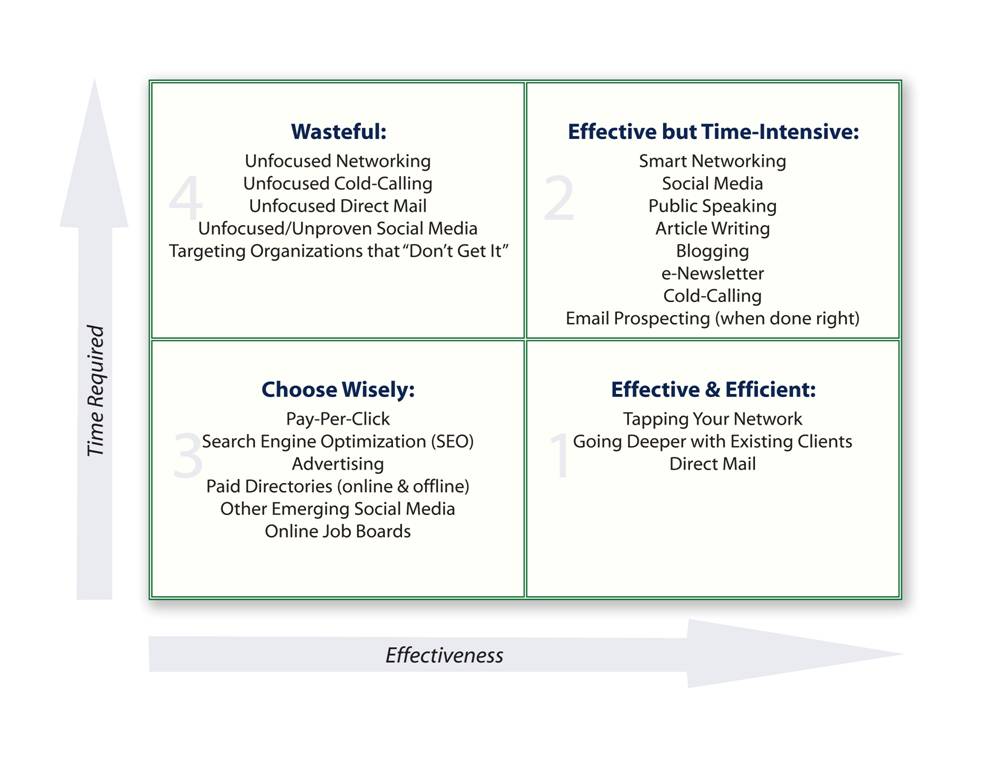Last week we discussed the three essential pillars for a sound marketing strategy:
- Pillar #1: Have absolute clarity about your ideal client.
- Pillar #2: Go after “hungrier” markets.
- Pillar #3: Implement proven and reliable marketing tactics that yield disproportionately high results.
In this article, we’re going to build the framework for making smart decisions about where and how you spend your limited resources.
That’s where the Marketing Effectiveness Matrix™ (MEM) comes in.
The MEM, which I cover in detail in my book The Wealthy Freelancer, classifies the most common marketing tactics by how effective they are and how much time they take to develop and execute. The MEM helps you make lead-generating decisions based on your specific goals and your unique situation.
Let’s take a look at the MEM:

As you can see, it’s divided into four quadrants:
Quadrant 1 contains lead-generating tactics that tend to be highly effective and time-efficient.
Quadrant 2 contains tactics that are also very effective but require more time to develop and execute. Regardless of your goals, most of your efforts should revolve around these first two quadrants.
Quadrant 3 contains tactics that could work well, but you have to be very selective, as these tactics are often less effective than the tactics in the first two quadrants.
Finally, Quadrant 4 contains mostly wasteful tactics. They take too long to carry out. They also deliver questionable (or very little) value. Amazingly, many freelancers spend an inordinate amount of time in this quadrant. And this is where you end up when you start trying different tactics out of desperation. That’s why it’s important to have a sound freelance marketing plan. Otherwise it’s easy to confuse “activity” with “effectiveness.”
Once you understand how these tactics are classified, you can use the MEM to make lead-generating decisions that work best for you and suit your goals, skills, and personality. But try to stick to marketing tactics contained in Quadrants 1 and 2. These tactics will yield the best results for your time and effort.
And to make sure you actually implement these tactics and increase your chances of getting value from them, here’s what I strongly recommend you do: pick two to four tactics only!
Out of your two to four strategies, make sure to pick at least one INBOUND tactic and one OUTBOUND tactic. Inbound tactics attract prospects to you. These are things like blogging, article writing, some forms of networking, SEO, and social media.
When done right, inbound tactics can generate a steady stream of high-quality inquiries. Which is great and all, but inbound tactics don’t really give you control over who inquires about your services. You’re at the mercy of whatever’s happening out there.
With outbound tactics you’re reaching out to prospects. For instance, direct mail, tapping your network, and cold calling are all outbound tactics. You’re not waiting for prospects to come to you, you’re reaching out to them. Because you’re the one taking action, you have more control over them than inbound tactics. However, they do tend to take up more time and effort to execute than many forms of inbound marketing.
As you can see, there are pros and cons to both inbound and outbound tactics. Which is why it’s best to have a mix of both.
Set Aside Time Every Week
Finally, it’s important to carve out time to implement your marketing system. Don’t make the mistake of picking a series of tactics and then hoping you’ll get them done. MAKE the time!
And the best way to ensure your marketing gets done is to schedule time for it. Treat your own marketing as an actual client project. In fact, it’s a project for your most important client — you!
Also, keep in mind that not all of this time will be used for outbound strategies. Much of this time will be spent on creating marketing materials, campaigns, and other internal elements of your marketing efforts. So when I say “spend X number of hours every week marketing,” I’m NOT just talking about spending that time making cold calls or going to networking events.
At a minimum, commit to spending 10 percent of your workweek on marketing-related activities. Do that consistently and you’ll quickly gain the critical mass you need to attract all the business you want.
What Did You Gain From This?
I’d love to hear from you regarding how this information resonated. In the comments area below, name ONE specific insight you gained from this article and how it will help you along your journey of business improvement.
Go ahead, don’t be shy! We’re all family here.
Save
Save